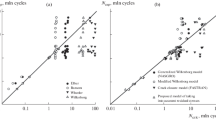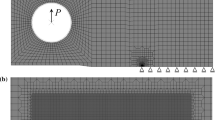Abstract
The delayed retardation phenomena of fatigue crack growth resulting from a single application of overload were investigated for five steels, two aluminium alloys and a titanium alloy. As long as the small scale yielding condition was satisfied at the overloaded crack tips, the retardation behaviour of these materials was expressed consistently by four parameters; the peak/baseline stress ratio, r, the exponent in the Paris equation, m, the overload-affected zone size, ω D, and the crack distance at the minimum rate of crack growth, ω B. Then the parameters, ω B and ω D, characterizing the retardation phenomena for these materials were determined. The retardation of aluminium alloys was stronger than that of the other materials. This is attributed to the lower value of ω B/ω D in aluminium alloys than in the other materials. In the case of r=2, the overload-affected zone sizes, ω D, were nearly equal to 1.5ω 0 in HT80 steel and aluminium alloys, slightly lower than 1.5ω 0 in SNCM8 steel and much larger than 1.5ω 0 in A553 steel and the titanium alloy, where ω 0 is the monotonic plastic zone size calculated according to the Dugdale model. The dependence of retardation on baseline stress intensity, ΔK 1, appeared somewhat complicated. In the cases of A553 steel and A2017 aluminium alloy the amount of retardation increased with increasing ΔK 1 value, while in the cases of HT80 steel and Ti-6A1-4V titanium alloy the tendency appeared in the reverse direction. The former behaviour was related to the change in the stress state from plane strain to plane stress at the overloaded crack tips and the latter was related to the threshold of stress intensity.
Similar content being viewed by others
References
J. Schijve, Rep. MP195, National Luchtvaart Lavoratorium, Amsterdam (1960).
W. Elber, ASTM Spec. Tech. Pub. No. 486 (1971) 230.
S. Matsuoka, K. Tanaka and M. Kawahara, Eng. Fracture Mech. 8 (1976) 507.
E. F. J. von Euw, R. W. Hertzberg and R. Roberts, ASTM Spec. Tech. Pub. No. 513 (1972) 230.
R. P. Wei and T. T. Shih, Int. J. Fracture 10 (1974) 77.
W. J. Mills and R. W. Hertzberg, Eng. Fracture Mech. 7 (1975) 705.
G. M. Crandall and B. M. Hillberry, Proceedings of the Fourth International Conference on Fracture, Waterloo, Canada, Vol. 2 (1977) p. 1009.
D. S. Dugdale, J. Mech. Phys. Solids 8 (1960) 100.
R. W. Landgraf, JeDean Morrow and T. Endo, J. Mater. 4 (1969) 176.
R. E. Feddersen, ASTM Spec. Tech. Pub. No. 410 (1966) 77.
S. Matsuoka and K. Tanaka, Preprints of JSME (in Japanese) (1977).
G. T. Hahn, R. G. Hoagland and A. R. Rosenfield, Met. Trans. 3 (1972) 1189.
M. Klesnil and P. Lukas, Mater. Sci. Eng. 9 (1972) 231.
A. Ohta and E. Sasaki, Eng. Fracture Mech. 9 (1977) 307.
Idem, Preprints of JSME (in Japanese) (1977).
R. J. Bucci, P. C. Paris, R. W. Hertzberg, R. A. Schmidt and A. F. Anderson, ASTM Spec. Tech. Pub. No. 513 (1972) 125.
K. Tanaka and S. Matsuoka, Int. J. Fracture 13 (1977) 563.
Author information
Authors and Affiliations
Rights and permissions
About this article
Cite this article
Matsuoka, S., Tanaka, K. Delayed retardation phenomena of fatigue crack growth in various steels and alloys. J Mater Sci 13, 1335–1353 (1978). https://doi.org/10.1007/BF00544741
Received:
Accepted:
Issue Date:
DOI: https://doi.org/10.1007/BF00544741




